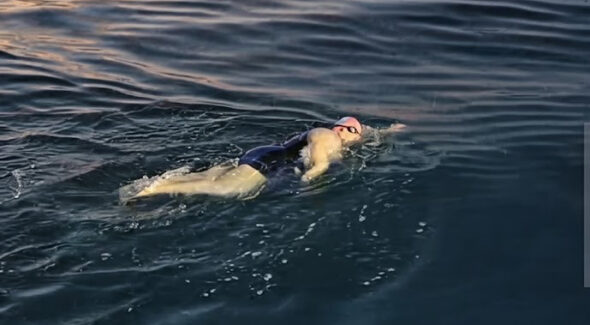
Villager Amy Wamsley, pictured in the English Channel, completed her solo crossing in 16 hours and 56 minutes. (Submitted photo)
Across the English Channel — and back
- Published: October 16, 2025
When Amy Wamsley stepped onto the beach at Sangatte, France, on June 13 this year, she did so to the sounds of cheers and a boat horn. She turned 50 that day.
And what’s more, the Yellow Springs resident had just completed the swim of her life: 21 miles across the English Channel, in 16 hours and 56 minutes. She had fulfilled a promise she’d made to herself as a child: to swim the Channel the year she turned 50.
“I cried. I bawled hysterically,” Wamsley said in a recent interview, more than three months after her swim. “I was just like, ‘I did this. Oh my god, I did this.’”
Upon stepping into the sand in France, Wamsley became the second Ohio woman ever to successfully swim the English Channel. The first was Tina Bischoff of Columbus in 1976 — one year after Wamsley was born.
Her crossing was a personal triumph — but for the many villagers who followed her progress through live updates on WhatsApp and social media, Wamsley’s achievement also became a community event.
And it almost didn’t happen.
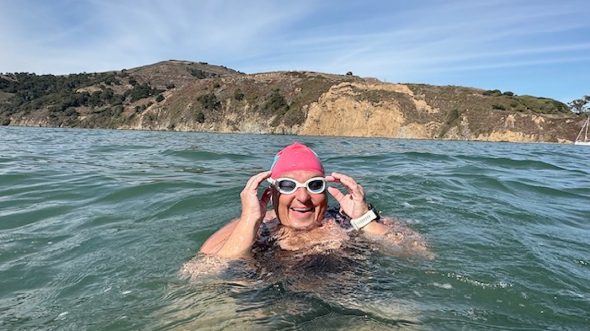
Local resident Amy Wamsley completed her successful swim across the English Channel on June 13, 2025. She’s pictured here swimming around Coronado Island in one of the many preparatory swims that led up to today’s successful swim. (Submitted photo)
A life-changing swim
Wamsley began training in earnest for the English Channel swim last year, completing a number of open-water training swims, in addition to frequent long-distance lap swims in pools.
This spring, Wamsley headed to England, where she would swim from Dover — but her challenges began before she ever touched the water.
As the News reported in June, Wamsley had been given an 11-day window, May 30–June 10, during which her escort boat crew would decide when conditions were safe enough to swim. But weather delays kept her waiting in Dover, with friends and family in Yellow Springs following updates and “waiting with bated breath” to hear when she would be cleared to go.
On June 10, with her swim delayed beyond the designated window, she told the News: “I’m refusing to leave, and the team is staying to support me. I have a stellar crew behind me who have stated they are going to do everything they can to keep me in that water.”
After several false starts, she finally received a start date: Friday, June 12, just before she turned 50. Once she entered the Channel, however, the real challenges began.
“For the first three hours I was really sick, from fumes from the boat,” she said. “I puked off and on the entire time. … I was literally not fine. My vision was blurry. My face was burning. And I thought, ‘I’m only two hours in. How am I going to swim another 12, 15, 16 hours like this?’”
Wamsley said those monitoring her swim were close to pulling her out — and if she had signaled to them that she was flagging, she said, she was sure they would have. But she remembered the promise she’d made to herself — that she would only stop if she was in danger of dying.
“And I told myself, ‘You’re not dying, you just don’t feel good — so keep swimming,’” she said.
Wamsley added that it’s not unusual for her to vomit during long swims — “Oh yeah, I throw up all the time,” she said with a laugh — but in this case, her nausea cost her more than comfort: She vomited up her motion-sickness medication, and then struggled to keep down any food during her 30-second feeding breaks every half-hour.
Her support team — local residents Vanessa Gueth and Victoria Walters — worked with her feeder, Suzanne Martin, who has supported dozens of Channel swims, to improvise.
“They squirted [energy gels] together with warm water and made some type of concoction that was, like, 35 to 45 milligrams of caffeine,” she said. “I was like, ‘Is this tea?’ They said, ‘We’ll tell you what it is later. Just drink it.’”
Along with bites of salted caramel protein cookies, it was just enough to keep her fueled.
There were other setbacks, too: Because her early sickness slowed her pace, despite having “rockstar water conditions” to swim in, she missed the tide, which she knew would prolong the time she spent in the water.
“I thought, ‘OK, I’m going to have another six or eight hours in the water,’” she said. “I just started crying. And literally, I was sobbing for a whole 10 minutes — and then I thought, ‘OK, you’re fine. Let’s go.’”
There was also a storm brewing behind her, Wamsley added — one that meant she had to double her pace part-way into the swim. Walters and Gueth shouted encouragement from the deck, and Martin gave precise instructions in “swimmer language” about currents and pace. Wamsley noticed at this time that she was tired, but didn’t feel sore — a realization that spurred her on.
“I said to myself, ‘If I’m not sore, I’m not swimming fast enough — and how dare I get in the English Channel and not swim my hardest?’” Wamsley said.
Not everything was grim. Wamsley said she never entered a “dark place” mentally, as she said some other Channel swimmers had told her was common. Instead, she kept her focu
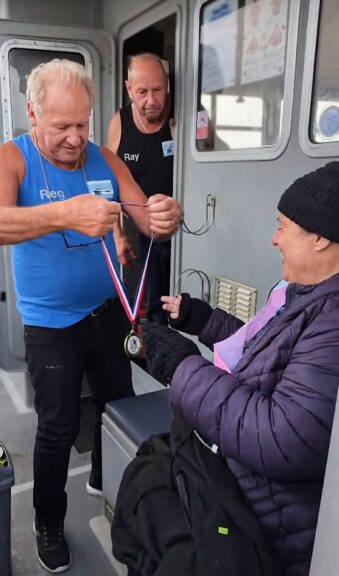
(Submitted photo)
s sharp, keeping track of her body, her stroke, the people on the boat. She saw jellyfish — “I actually caught a jellyfish and threw it, but it didn’t sting me, which is crazy,”she said — and watched the French coastline inch closer.
There were scares, too. Nearing land, a dredger boat passed by, creating waves. Exhausted and struggling with depth perception after hours in her goggles, one wave, with the cliffs of the ever-nearing land behind it, appeared enormous and as though it was about to crash down on her. Her team signaled her to move away from the boat — and luckily she did, as the wave in question dramatically rocked the boat.
“That boat went up on its end and twisted and came back down,” she said. “If it had landed on me, it would have killed me.”
Nearing the end of her swim, Wamsley said she was nearly pushed into an exclusion zone — that is, an area where swimming is not allowed due to proximity to ship traffic and other hazards — where she might have been pulled out by the boat crew before finishing her swim. But she swam on — and just shy of 17 hours after leaving England, landed at Sangatte on the coast of France.
“I was so happy I landed there because it was a sandy beach, and everywhere else is rock,” she said.
On-shore, and not yet fully comprehending what she’d just accomplished, Wamsley said she hailed a nearby French paddleboarder.
“I was on the ground, and I told him, ‘I just swam from England, it’s my 50th birthday!’ — he looked confused, but he said, ‘Congratulations!’” she said.
The paddleboarder tried to help her up. Wamsley had to wave him off: by Channel Swimming Association rules, she had to leave the water unassisted. She staggered onto shore, fell, got up again and walked until she finally stood on completely dry sand. Not allowed to stay on French soil long, she picked up a mussel shell as a lone memento of her swim.
“I went to get on the boat, and a wave came in,” she said. “I hit a rock, I fell. I crushed my shell.”
Wamsley’s disappointment didn’t last long. Back aboard, her pilot presented her with a medal commemorating her solo swim. Medals aren’t typical, she said, but are being awarded by the Channel Swimming Association this year — the 150th anniversary of the first successful unaided swim across the English Channel by Captain Matthew Webb in 1875.
On shore, looking ahead
A strong storm had just passed in Dover after the two-hour boat ride from France. Back at her rental house, Wamsley said, all she wanted to do was take a bath. Lying in the warm water, she said, the pain began to set in.
“And it was in unexpected places — like, I expected my arms to hurt, but my wrists hurt so bad,” she said.
Her hunger came back, too — her first proper meal was two popsicles, a Cadbury chocolate-orange pudding and a peanut butter and raspberry sandwich.
What didn’t come right away was sleep; she dozed for maybe half an hour, but her adrenaline was “still up and going.” Instead of sleeping right away, Wamsley stayed awake reading the entire feed of messages from supporters back home.
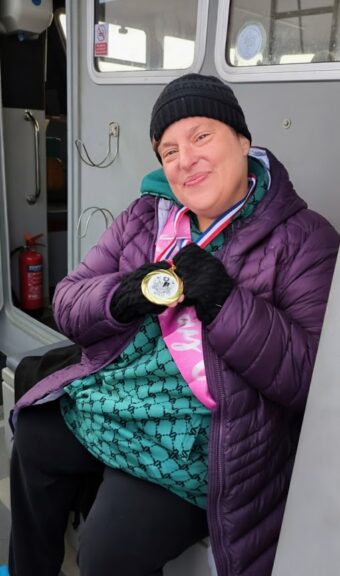
(Submitted photo)
“I was bawling by the end,” she said. “It was amazing.”
When she returned to Yellow Springs days later, Wamsley received a police escort into town. Friends and neighbors lined Xenia Avenue, cheering.
“I have no words to explain how amazing it felt to come home and have all these people just congratulating me,” Wamsley said. “People still stop me to congratulate me and tell me they’re proud I met my goal.”
Strangers have recognized her in public. Letters have arrived from around Ohio and beyond. A librarian who swims sent her a list of favorite books. News stations picked up her story nationwide.
Three months after crossing the English Channel, Wamsley found herself in another historic swim — though a shorter one. On Sept. 21, she joined 300 swimmers in Chicago for the first organized swim in the Chicago River in nearly a century, traveling two miles in the water.
The event, staged by the nonprofit A Long Swim to benefit ALS research, symbolized decades of cleanup that have turned the once-polluted waterway into a swimmable course. The swim aligned neatly with the future work of Amy’s Swimventure, a nonprofit she founded last year with the dual purpose of empowering women and increasing visibility for the importance of clean waterways.
The Chicago River swimmers, who had all raised money for A Long Swim in order to participate, had their swim-times tracked. Wamsley said she finished dead last in her category — but swimming fast wasn’t her goal. Having taken a months-long break from swimming after the English Channel, she said it felt good to be back in the water.
“I just wanted to enjoy it — I was in the river, playing in the water, and it had been 98 years since it was clean enough to do that,” she said. “I could see my hands, I could see the swimmers in the water next to me, it felt good. I just wasn’t in a hurry.”
As for her next big challenge, Wamsley is already looking beyond Chicago. She has her eye on the American Triple Crown of open-water swimming: New York’s 28.5-mile Manhattan Island Marathon Swim, California’s Catalina Channel and the English Channel she has already conquered.
And then there’s the North Channel, between Ireland and Scotland — colder, harsher, notorious for brutal conditions and swarms of Lion’s Mane jellyfish.
“For some reason, I really want to try the North Channel,” she said.
Wamsley doesn’t yet know when that swim will happen. For now, she’s still reflecting on what the English Channel crossing has already given her.
“My entire life has changed,” she said. “I feel like I can talk about moving forward and living your dreams — because I’ve lived mine.”
The Yellow Springs News encourages respectful discussion of this article.
You must login to post a comment.
Don't have a login? Register for a free YSNews.com account.







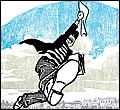







No comments yet for this article.